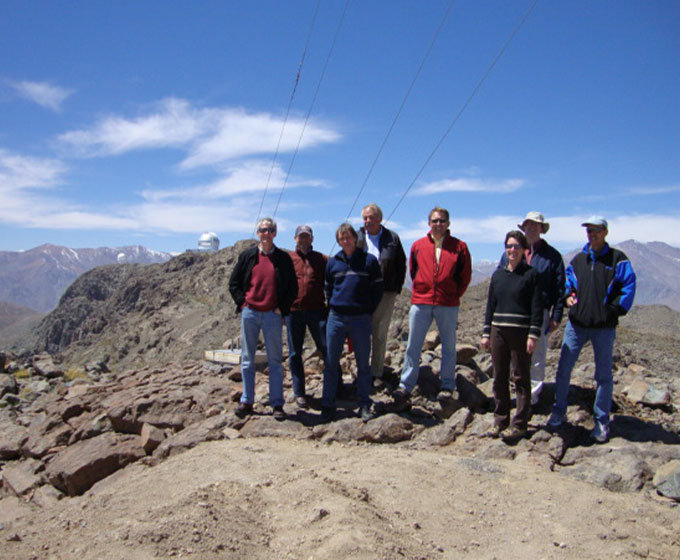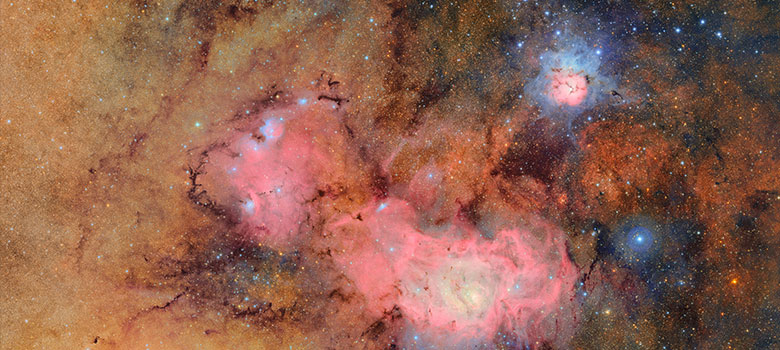
UTSA professor David Silva (second from the left) poses for a team photo at the summit of Cerro Pachón in Chile, which is now home to the Vera C. Rubin Observatory.
JULY 17, 2025 — All good science begins with a question. Or in the case of the newly operational Vera C. Rubin Observatory perched atop a mountain in Chile, it was five specific questions.
“We were looking to answer, ‘How do dark matter and dark energy shape the universe we live in?’” said David Silva, UTSA distinguished professor of physics and astronomy.
“’How many asteroids are contained by our solar system and which ones could collide with the Earth?’ ‘How did the Milky Way form and evolve?’ ‘Can we detect objects throughout the universe undergoing explosive changes during their disruption event?’”
Answers to those questions could come from a telescope with the world’s largest digital camera, a project with initial concepts thanks in part to Silva.

This image combines 678 separate images taken by NSF–DOE Vera C. Rubin Observatory in just over seven hours of observing time. Combining many images in this way clearly reveals otherwise faint or invisible details, such as the clouds of gas and dust that comprise the Trifid nebula (top) and the Lagoon nebula, which are several thousand light-years away from Earth. Photo Courtesy of NSF–DOE Vera C. Rubin Observatory.
Director of the UTSA Center for Space Technology & Operations (CSTOR), Silva led the National Optical Astronomy Observatory (NOAO) from 2008 to 2019 when plans were underway for a new observatory. Completed last year, the observatory houses an 8.4-meter survey telescope with the world’s largest digital camera that feeds a powerful data processing system.
“In the early days, our role was to work on the initial concept for the telescope and figure out how we were going to manage the project — everything from site testing to infrastructure support,” Silva said. “So many people were contributing to this project [including] multidisciplinary teams of scientists, engineers, administrative support and expert machinists, to name a few.”
First images
Nearly three decades in the making, the observatory revealed its first images from the survey telescope in June. Silva said the goal of creating the observatory was to launch the Legacy Survey of Space and Time (LSST) camera with the mission to photograph the night sky every three days for 10 years.
The result will provide an ultrawide, ultra-high-definition time-lapse record of the universe, according to the observatory. Images will reveal asteroids and comets, pulsating stars and supernova explosions, along with far-off galaxies and perhaps cosmic phenomena never seen before.
A single image taken by the LSST Camera covers an area of the sky as big as 45 full moons.
Petabytes of data
“It will be the largest astronomical database — and maybe the largest public science database — ever created, holding about 500 petabytes of processed data, equivalent to 106 million DVDs stacked 80 miles high,” Silva said. “Not only will the LSST database be an amazing engine for scientific discovery, but it also provides an exciting and inspirational training platform for people to hone their computation and data science skills.”
“That aspect alone better prepares scientists for the information/databased economy of the 21st century,” he added, “Especially for universities like UTSA that are training the next generation of experts in the fields of computing and data science.”
The thousands of images the Rubin Observatory will collect in its 10-year mission will help scientists understand everything from the nature of dark matter to other large-scale cosmic mysteries.
“We are in a remarkable moment in our understanding of the physical universe,” Silva said. “LSST’s database will offer opportunities for the worldwide community to study certain things about the universe and find answers to scientific questions that haven’t been thought about before.”
UTSA Today is produced by University Communications and Marketing, the official news source of The University of Texas at San Antonio. Send your feedback to news@utsa.edu. Keep up-to-date on UTSA news by visiting UTSA Today. Connect with UTSA online at Facebook, Twitter, Youtube and Instagram.
Move In To COLFA is strongly recommended for new students in COLFA. It gives you the chance to learn about the Student Success Center, campus resources and meet new friends!
Academic Classroom: Lecture Hall (MH 2.01.10,) McKinney Humanities BldgWe invite you to join us for Birds Up! Downtown, an exciting welcome back event designed to connect students with the different departments at the Downtown Campus. Students will have the opportunity to learn about some of the departments on campus, gain access to different resources, and collect some giveaways!
Bill Miller PlazaCome and celebrate this year's homecoming at the Downtown Campus with food, games, giveaways, music, and more. We look forward to seeing your Roadrunner Spirit!
Bill Miller PlazaThe University of Texas at San Antonio is dedicated to the advancement of knowledge through research and discovery, teaching and learning, community engagement and public service. As an institution of access and excellence, UTSA embraces multicultural traditions and serves as a center for intellectual and creative resources as well as a catalyst for socioeconomic development and the commercialization of intellectual property - for Texas, the nation and the world.
To be a premier public research university, providing access to educational excellence and preparing citizen leaders for the global environment.
We encourage an environment of dialogue and discovery, where integrity, excellence, respect, collaboration and innovation are fostered.